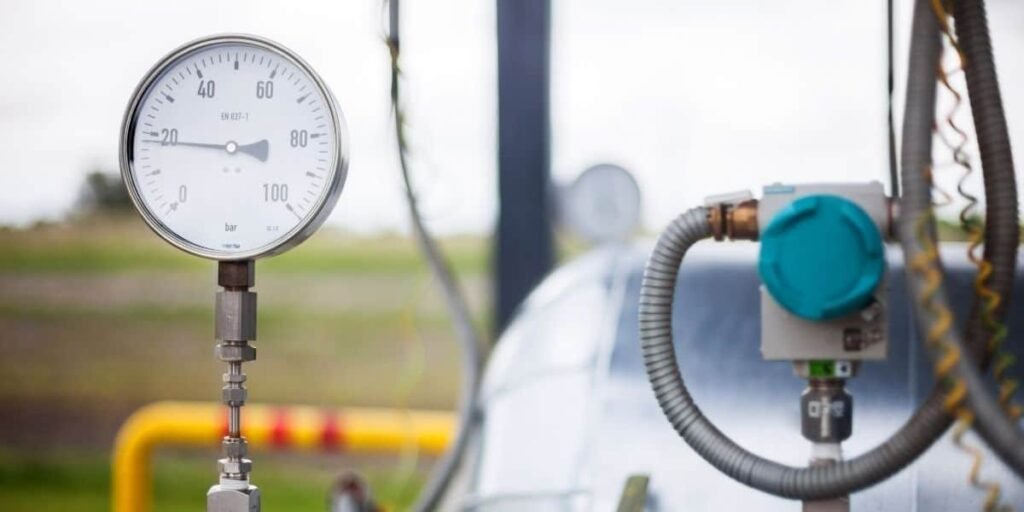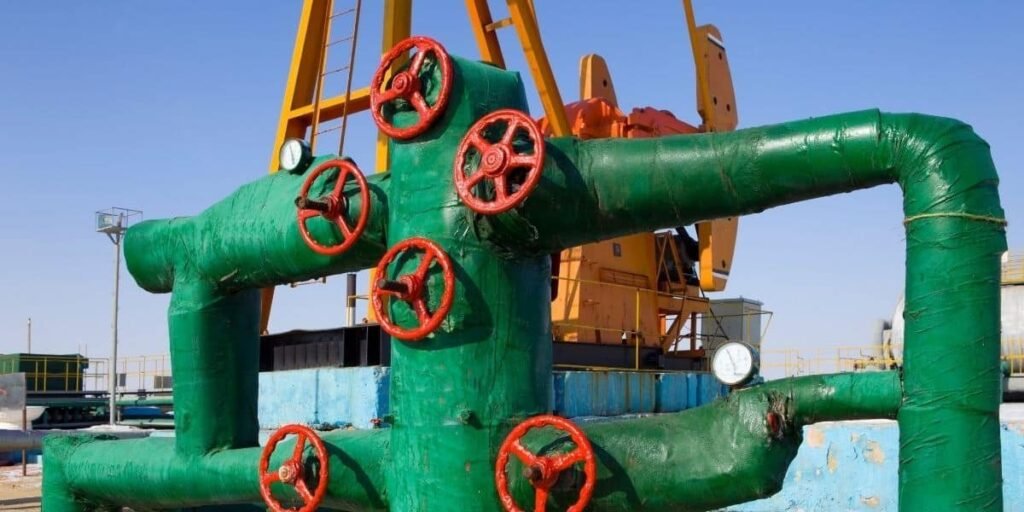The benefits of implementing wellhead automation involve integrating advanced technology to control and monitor oil and gas production processes at the healthy site. This represents a significant evolution in the industry, replacing traditional manual methods with sophisticated software.
The implementation of wellhead automation is one of the critical strategies revolutionizing the oil and gas industry today. Companies are seeking to optimize production, ensure safety, and minimize environmental impact. From increased operational efficiency to cost savings and beyond, automated systems at wellheads offer a wide range of benefits.
Key Takeaways
Oil and gas companies can benefit from wellhead automation in a number of ways, including increased operational efficiency, enhanced safety measures, and optimal resource utilization.
The automation of wellheads contributes to environmental stewardship by minimizing emissions, reducing waste, and ensuring compliance with environmental laws.
By using automation technology, companies can optimize production strategies, improve asset management, and reduce costs.
The integration of IoT and AI technologies in the oil and gas sector has the potential to drive innovation and optimize operations.
For companies seeking to stay competitive and sustainable in the industry, wellhead automation is a worthwhile investment despite the initial investment required.
Benefits of Implementing Wellhead Automation in the Oil and Gas Industry
By automating various processes like valve control, data monitoring, and equipment diagnostics, companies can streamline their operations and significantly increase operational efficiency. Automation systems need to be designed to meet industry regulations and address vulnerabilities from connectivity and network access, ensuring robust security measures are in place. With automated systems, production parameters can be continuously monitored and adjusted, resulting in optimized production rates and reduced downtime.
Additionally, automation reduces the need for manual intervention, reducing human error and improving overall efficiency. By automating wellheads, companies can improve their competitiveness in the market by achieving higher production levels while maintaining consistent quality standards.
Enhanced Safety Measures
Wellhead automation plays an important role in improving safety measures in the oil and gas industry. Automation systems need to be designed to meet industry regulations and address cybersecurity risks to ensure enhanced safety measures. Using automated systems, operators can monitor production processes and equipment conditions in real-time, identifying potential hazards before they occur.
Automating wellheads helps mitigate risks to personnel and assets by detecting anomalies and implementing preventative measures, such as automatic shutdowns in an emergency. Overall, wellhead automation facilitates a safer working environment by reducing the need for manual inspections in hazardous environments, minimizing worker exposure to safety hazards.

Optimal Resource Utilization
Wellhead automation facilitates optimal resource utilization by efficiently allocating workforce and equipment. Automation systems play a crucial role in regulatory compliance and addressing cybersecurity risks, thereby facilitating optimal resource utilization. Automated systems simplify routine tasks and maintenance activities, enabling employees to devote more time to strategic initiatives.
Labor costs can be reduced, and workforce productivity can be increased by reducing the need for manual interventions. In addition, automated asset management systems allow companies to maximize the value of their resources and reduce operational expenses by maximizing the value of their resources. Automating the wellhead allows companies to achieve greater operational efficiency and maximize the value of their resources.
Environmental Benefits
Wellhead automation offers significant environmental benefits by reducing the industry’s carbon footprint and mitigating its environmental impact. Automation systems need to be designed to meet environmental regulations and address cybersecurity risks to ensure environmental benefits. Automation systems help minimize emissions by controlling production processes and equipment more precisely.
Wellhead automation promotes sustainability and environmental stewardship by optimizing production parameters and reducing energy consumption. Automated monitoring and control systems ensure compliance with regulatory requirements and detect and address environmental issues promptly. As a whole, wellhead automation contributes to a cleaner and more sustainable future for the oil and gas industry.
Data-Driven Decision Making
Data-driven decision-making empowers companies with valuable insights through wellhead automation. Automation systems need to be designed to meet industry regulations and address cybersecurity risks to facilitate data-driven decision-making. Automated systems collect data from sensors and monitoring devices in real-time, providing operators with actionable information about production processes and equipment performance.
In order to make informed decisions, companies analyze this data to identify trends, patterns, and potential issues. In addition, wellhead automation facilitates predictive maintenance strategies, allowing companies to anticipate equipment failures and address maintenance needs in advance. Organizations can improve efficiency, optimize operations, and enhance performance by using data-driven decision-making.
Increased Operational Efficiency
By integrating advanced technology at the well site, companies can streamline production processes, reduce downtime, and improve productivity. Automation systems need to be designed to meet industry regulations and address cybersecurity risks to ensure increased operational efficiency. Wellhead automation leads to improved operational efficiency in the oil and gas industry.
Tasks such as valve control, data monitoring, and equipment diagnostics can be performed more efficiently with automated systems than with manual systems. Automation solutions provide operators with real-time monitoring and control capabilities, allowing them to identify and address issues promptly, optimize operations, and reduce delays.
Enhanced Safety Measures
Using wellhead automation in the oil and gas industry enhances safety by reducing the risks associated with manual operations. Automation systems need to be designed to meet industry regulations and address cybersecurity risks to ensure enhanced safety measures. Operators can identify potential hazards immediately and take preventive measures to mitigate them with real-time monitoring and control capabilities.
By reducing the need for human intervention in hazardous environments, automated systems reduce the risk of personnel injuries and accidents. In addition to improving safety performance and operational integrity, wellhead automation contributes to a safer working environment for both workers and equipment.
Optimal Resource Utilization
By automating repetitive tasks and routine inspections, companies can optimize workforce productivity and allocate workforce more efficiently by implementing wellhead automation. Automation systems need to be designed to meet industry regulations and address cybersecurity risks to facilitate optimal resource utilization.
The use of automated asset management systems allows the equipment to be used more effectively, extending its lifespan and reducing operational costs. With wellhead automation, companies can maximize operational efficiency and maximize return on investment by streamlining resource allocation and minimizing waste.

Environmental Benefits
Wellhead automation in the oil and gas industry has significant environmental benefits. Automation systems need to be designed to meet environmental regulations and address cybersecurity risks to ensure these environmental benefits. Companies can reduce their ecological footprint and adhere to strict regulations by reducing waste, minimizing emissions, and implementing efficient production practices.
Using automated systems, companies can monitor and control environmental parameters in real time, ensuring compliance with environmental standards and minimizing the impact of their operations on local ecosystems. Wellhead automation contributes to environmental stewardship and corporate responsibility by fostering a greener and more sustainable industry.
Data-Driven Decision Making
One of the most compelling benefits of wellhead automation is its ability to facilitate data-driven decision-making. Automation systems need to be designed to meet industry regulations and address cybersecurity risks to ensure robust security measures. Companies can gather real-time data on production processes, equipment performance, and reservoir dynamics using advanced sensors and monitoring systems.
By analyzing this data, trends can be identified, production strategies can be optimized, and proactive maintenance can be implemented. With wellhead automation, operators can make informed decisions that drive efficiency and profitability through actionable insights into operational performance.
Data Management and Analytics
In the oil and gas industry, data management and analytics are pivotal, especially when it comes to wellhead automation. Automated systems are capable of collecting and analyzing vast amounts of data from various sources, including sensors, equipment, and production processes. This wealth of data provides valuable insights into operational efficiency, production rates, and equipment performance.
By leveraging advanced data analytics tools and techniques, oil and gas companies can optimize their operations, reduce costs, and improve decision-making. Effective data management and analytics enable companies to enhance production forecasting and planning, optimize equipment maintenance, and reduce downtime. Additionally, these capabilities improve regulatory compliance and reporting, ensuring that companies meet industry standards and regulations.
In essence, data-driven decision-making empowers oil and gas companies to achieve greater operational efficiency and maintain a competitive edge in the industry.
Predictive Maintenance and Optimization
Predictive maintenance and optimization are critical components of wellhead automation in the oil and gas industry. By leveraging advanced sensors, machine learning algorithms, and data analytics, oil and gas companies can predict equipment failures, optimize maintenance schedules, and reduce downtime.
Predictive maintenance helps to reduce equipment failures and downtime by identifying potential issues before they become critical. This proactive approach allows companies to optimize maintenance schedules, reducing costs and improving operational efficiency. Enhanced safety measures and reduced risk of accidents are additional benefits of predictive maintenance, contributing to a safer working environment.
Advanced technologies such as machine learning algorithms, IoT devices, and data analytics tools play a crucial role in achieving predictive maintenance and optimization. These technologies enable companies to implement predictive modeling and simulation, further enhancing their ability to anticipate and address maintenance needs.
Cost Savings and ROI
Investing in wellhead automation offers significant cost savings and return on investment (ROI) to oil and gas companies. Automation systems need to be designed to meet industry regulations and address cybersecurity risks to ensure cost savings and ROI. Long-term financial benefits outweigh the initial investment in automation technology, even though the initial investment may seem substantial.
Over time, companies can save substantial amounts of money by reducing downtime, minimizing maintenance expenses, and optimizing production efficiency. In addition, as companies reap the benefits of improved productivity, improved safety measures, and environmental stewardship, the ROI becomes increasingly evident.
Integration with IoT and AI Technologies
Thanks to the Internet of Things (IoT) and artificial intelligence (AI), wellhead automation is evolving rapidly. Automation systems need to be designed to meet industry regulations and address cybersecurity risks to ensure successful integration with IoT and AI technologies. Incorporating IoT devices into the system enables seamless connectivity and data exchange, while artificial intelligence algorithms facilitate autonomous decision-making and predictive maintenance.
In the oil and gas industry, this convergence of technologies holds immense potential for driving innovation and optimizing operations. Technology such as IoT and AI can unlock new opportunities for efficiency, productivity, and competitiveness for companies.

Challenges and Considerations:
Despite its many benefits, wellhead automation also presents challenges that need to be overcome. Automation systems need to be designed to meet industry regulations and address vulnerabilities from connectivity and network access, emphasizing the importance of robust security measures. The critical considerations for companies adopting automated systems include implementation challenges, workforce readiness, and integration complexities. In order to overcome these challenges, careful planning, robust training programs, and a commitment to continuous improvement are necessary.
Regulatory Landscape:
Wellhead automation must adhere to industry best practices and regulatory standards to ensure safety, environmental responsibility, and operational integrity. Automation systems need to be designed to meet industry regulations and address cybersecurity risks to ensure compliance with the regulatory landscape. Companies must stay abreast of evolving regulations and take proactive measures to ensure compliance and safeguard their operations.
Technological Integration and Compatibility:
Successful wellhead automation in the oil and gas industry hinges on technological integration and compatibility. Oil and gas companies must ensure that their automated systems are compatible with existing infrastructure, equipment, and software. This requires careful planning, testing, and validation to ensure seamless integration and minimal disruption to operations.
Key considerations for technological integration and compatibility include ensuring that automated systems are compatible with existing infrastructure and equipment, integrating with existing software and systems, and maintaining scalability and flexibility to accommodate changing operational requirements. Additionally, cybersecurity and data protection are paramount, as is ensuring regulatory compliance and reporting.
By addressing these considerations, oil and gas companies can achieve successful technological integration, enabling them to optimize operations and maintain a competitive edge in the industry.
Workforce Transition and Training:
As the oil and gas industry embraces wellhead automation, workforce transition and training become critical components of success. Automated systems replace manual processes, necessitating the retraining and upskilling of workers to effectively operate new technologies. A strategic approach to workforce development is essential, encompassing training and development programs, change management, and communication.
Key considerations for workforce transition and training include identifying skills gaps and training needs, developing effective training programs and materials, managing change and communication, and evaluating performance and providing feedback. Additionally, fostering a culture of innovation and continuous learning is crucial to ensuring that workers remain adaptable and proficient in using automated systems.
By investing in workforce transition and training, oil and gas companies can ensure a smooth transition to automated systems, enhancing operational efficiency and maintaining a competitive edge.
Cybersecurity Risks and Mitigation:
Implementing wellhead automation in the oil and gas industry introduces new cybersecurity risks that must be addressed through robust security measures. Automated systems and IoT devices can create vulnerabilities that, if exploited, could compromise critical infrastructure and data.
Key considerations for cybersecurity risks and mitigation include identifying and assessing cybersecurity risks, implementing robust security measures and protocols, conducting regular security audits and testing, and developing incident response and disaster recovery plans. Ensuring regulatory compliance and reporting is also essential to maintaining operational integrity and continuity.
Effective cybersecurity measures help protect critical infrastructure and data, prevent cyber attacks and data breaches, and ensure regulatory compliance. By addressing cybersecurity risks, oil and gas companies can maintain their reputation and trust, ensuring the continued success of their wellhead automation initiatives.
Scalability and Flexibility
Different production environments require different kinds of scalable and adaptable wellhead automation solutions. Automation systems need to be designed to meet industry regulations and address cybersecurity risks to ensure scalability and flexibility. Companies need flexible solutions that can evolve as operational requirements change, whether they operate in conventional fields or unconventional reservoirs. By adopting scalable automation platforms, companies can stay competitive in a rapidly evolving industry landscape.

Future Trends and Predictions:
There is plenty of promise and potential in wellhead automation for the future. Automation systems need to be designed to meet industry regulations and address cybersecurity risks to ensure future trends and predictions are met. Machine learning, advanced sensors, and robotic systems are emerging technologies that will revolutionize production processes and open up new opportunities for efficiency and innovation. Through digital transformation and automation, companies can grow and optimize in a limitless way.
Conclusion:
In conclusion, wellhead automation represents a transformational change in the oil and gas industry, offering a multitude of benefits to companies trying to optimize their operations. Automation systems need to be designed to meet industry regulations and address cybersecurity risks to ensure the benefits of wellhead automation are fully realized. Automation technology delivers tangible value across all facets of production, from increased efficiency and enhanced safety to environmental stewardship and cost savings.
In a rapidly evolving industry landscape, companies can not only improve their bottom line by leveraging data-driven insights and integrating IoT and AI technologies but also position themselves for long-term success. Despite the initial investment required, wellhead automation is an undeniable strategic imperative for companies seeking to remain competitive and sustainable in today’s dynamic market.
Frequently Asked Questions:
What is wellhead automation?
Wellhead automation involves integrating advanced technology to control and monitor oil and gas production processes at the well site. Automation systems need to be designed to meet industry regulations and address vulnerabilities from connectivity and network access, ensuring robust security measures are in place. It replaces traditional manual methods with automated systems.
How does wellhead automation improve safety?
Wellhead automation enhances safety measures by minimizing risks associated with manual operations through real-time monitoring and control capabilities. Further, it is ensuring a safer working environment for personnel and equipment.
Are there any environmental benefits to wellhead automation?
Yes, wellhead automation offers significant environmental benefits. It minimizes emissions, reduces waste, and ensures compliance with environmental regulations. Further, it fosters a greener and more sustainable industry.
What industries can benefit from wellhead automation?
While the oil and gas industry stands to benefit the most, other industries, such as water management and industrial manufacturing, can also leverage similar automation technologies to optimize their operations.
How do companies justify the initial investment in wellhead automation?
Companies justify the initial investment in wellhead automation through long-term cost savings, increased operational efficiency, and enhanced safety measures. Further, it has environmental benefits that ultimately lead to a positive return on investment over time.
What are some challenges associated with implementing wellhead automation?
Implementation challenges may include integration complexities, workforce readiness, and overcoming resistance to change within the organization.
How scalable are wellhead automation solutions?
Companies can expand their automation capabilities and adapt to changing operational needs with wellhead automation solutions that are scalable.
What role do regulations play in wellhead automation?
Regulations play a crucial role in ensuring safety, environmental responsibility, and operational integrity in wellhead automation. Companies must adhere to regulatory standards and industry best practices to maintain compliance and safeguard their operations.
How does wellhead automation contribute to data-driven decision-making?
Wellhead automation provides real-time data analytics on production processes and equipment performance. Further, it reservoirs dynamics, enabling operators to make informed decisions and optimize production strategies.
What are the prospects of wellhead automation?
The future of wellhead automation is promising, with emerging technologies such as machine learning and advanced sensors poised to revolutionize production processes and unlock new opportunities for efficiency and innovation in the oil and gas industry.








1 thought on “Key Benefits of Implementing Wellhead Automation for Efficiency”
Comments are closed.